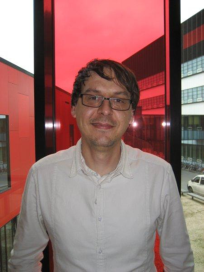Superconducting circuits with π-shift elements
Promotion date: 15. September 2011
Promotor: Prof. dr. ir. Hans Hilgenkamp
| This thesis presents three parts: the Superconducting Network Model, π-shift RSFQ circuits together with experimental aspects of YBCO/Nb ramp-type Josephson devices, and static π-shift circuits. It is shown that using the flux angle φ in superconducting networks, one can describe phenomena unique to superconductors in a more natural way, while still admitting the methods and tools developed for conventional network models. Experiments with π-shift RSFQ circuits are then presented, including the description of the used fabrication and measurement methods. At the end, a new type of π-shift structure is proposed - an inductively modulated π-loop - that can be used to implement superconducting digital circuits with very low power consumption. |
Was your work fundamental or more application oriented?
I am the last PhD in a series of about ten years of research on the π-shift phenomenon in high-Tc superconducting materials. Being a micro-electronics engineer with two-and-a-half years experience in IC design at Philips Semiconductors, my task was to apply my knowledge towards superconducting circuits that would benefit from a π-shift element.
This work indeed possessed a very considerable experimental component. Fabricating the thin-film superconducting devices involved using many different deposition machines and process steps as well as the modification of existing ones, in order to increase the physical yield of the samples.
In a crucial stage of the thesis project where, due to the complexity of both the fabrication and measurement methods, my experiments had not resulted in a functioning device, my promoter professor Hans Hilgenkamp was of great help. He provided advice and support to continue the work that resulted in the advent of simpler yet novel types of structures, similar to those used in quantum computing as flux qubits.
I was very happy to be able to actually fabricate and characterize these circuits and prove their principle of operation. The way Hans handled this shift in the research and encouraged me to adapt to the changes, was exceptional.
How did you develop personally, as a researcher and scientist?
My level of knowledge and skills has increased substantially. Being a circuit designer working behind the computer screen and only seeing the results coming from remote production lines, I now am used to using pipettes, tweezers, handling fluids and acids, as well as many types of deposition machines and cleanroom procedures.
Additionally, I now know more about the fundamentals of material science that are used in the application of thin films in industry. The thesis project did deliver what I intended when starting it. My knowledge horizon has expanded and I can confidently attack many different types of problems. I believe that will be of big advantage in my further career.
What are your future plans then?
I would like my work to involve both academic and entrepreneurial research. A scientist’s motivational drive is in fact curiosity: he is excited when something unusual is measured or predicted theoretically, regardless of its application potential. That is indeed the only process by which the boundaries of our collective knowledge can be structurally broadened. I am, however, also motivated by building and fabricating devices that have a certain purpose and functionality.
The post-doc position I am working in at the moment is a good mix of these two sides: academics and working towards real applications.
What, do you think, are the strong features of Mesa+?
I liked attending the colloquia and the Mesa+ days. What is of prime importance though, is the relaxed and zero-bureaucratic way the technicians approach the PhD’s performing their scientific research. Their door is always open. They helped me in many different ways, for example with expert advice on what chemicals and machines I could use best, in a given situation.
The success of Mesa+ depends not only on the institution but also on the (national) government and mostly society with regard to high-tech research. Only with passion for that, like in Asia for instance, can the Netherlands hope to play a front running role in technological developments in the future. Nanotechnology will be very important in that.
Therefore, Mesa+ should keep on finding ways to seek publicity and prove its relevance for society whenever chances do appear. Those chances will arrive, for example in the field of energy and advanced materials.

